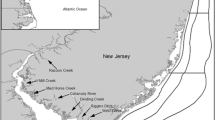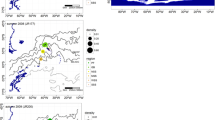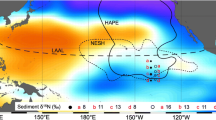Abstract
The eastern Pacific Ocean (EPO) covers ~ 55 million km2 of complex, dynamic habitats that can affect the distribution of ecologically and commercially important skipjack tuna, Katsuwonus pelamis, and its forage. The relationships between oceanography, ontogeny, and forage were quantitatively assessed to better understand skipjack tuna trophic ecology, and for parameterizing ecosystem models. Predator–prey dynamics of 320 skipjack tuna sampled from 1992 to 1994 and 2003 to 2005 were characterized—based on mean prey biomass (%\(\overline{W}\))—with respect to oceanographic biomes (Longhurst provinces), Oceanic Niño Index (ONI), year and skipjack tuna size, using a classification tree approach. Longhurst province was the most influential variable in explaining diet. Spatially, prey taxa richness was significantly lower, and taxonomic composition different, in predominant upwelling provinces compared to the primarily oligotrophic waters of the tropical offshore provinces. Anchovies comprised over 50%\(\overline{W}\) of diet composition in the ‘upwelling’ provinces whereas various epipelagic (51%\(\overline{W}\)) and mesopelagic fishes (28%\(\overline{W}\)) were important in the ‘central American coastal and tropical offshore’ provinces. An ontogenetic breakpoint in diet was identified by the classification tree at 547 mm fork length, with small skipjack tuna primarily consuming anchovies, Humboldt squid and krill and large skipjack tuna consuming epipelagic fishes and red crab. Identifying skipjack tuna foraging arenas by Longhurst province can help facilitate the development of a spatially explicit ecosystem model, while defining ‘life stanzas’ as at the 547 mm breakpoint in the EPO will provide more realistic representations of diet composition, consumption rates, and losses to predation and fishing in such models.






Similar content being viewed by others
Data accessibility
The datasets used in the current study are available from the corresponding author on reasonable request.
References
Alatorre-Ramírez VG, Galvan-Magaria F, Torres-Rojas YE, Olson RJ (2017) Trophic segregation of mixed schools of yellow fin tuna (Thunnus albacares) and skipjack tuna (Katsuwonus pelamis) caught in the eastern tropical Pacific Ocean. Fish Bull 115:252–269. https://doi.org/10.7755/FB.115.2.11
Alverson FG (1963) The food of yellowfin and skipjack tunas in the eastern tropical Pacific Ocean. Inter-Am Trop Tuna Comm, Bull 7:293–396
Au DWK (1986) Skipjack population dynamics; Is it qualitatively different from that of other tropical tunas? Proc ICCAT Intl Skipjack Yr Prog 1:189–197
Bernard HJ, Hedgepeth J, Reilly S (1985) Stomach contents of albacore, skipjack, and bonito caught off southern California during summer 1983. CalCOFI Rep 26:175–183
Blackburn M (1968) Micronekton of the eastern tropical Pacific Ocean: family composition, distribution, abundance, and relations to tuna. Fish Bull 67:71–115
Blackburn M (1969) Conditions related to upwelling which determine distribution of tropical tunas off western Baja California. Fish Bull 68:147–176
Blackburn M, Laurs RM (1972) Distribution of forage of skipjack tuna (Euthynnus pelamis) in the eastern tropical Pacific. NOAA Tech Rep NMFS SSRF- 649:16
Breiman L, Friedman JH, Olshen RA, Stone CJ (1984) Classification and regression trees. Wadsworth, Belmont, California
Chipps SR, Garvey JE (2007) Assessment of diets and feeding patterns. In: Guy CS, Brown ML (eds) Analysis and Interpretation of freshwater fisheries data. American Fisheries Society, Bethesda, Maryland, USA, pp 473–514
Coll M, Akoglu E, Arreguín-Sánchez F, Fulton E, Gascuel D, Heymans J, Libralato S, Mackinson S, Palomera I, Piroddi C, Shannon L, Steenbeek J, Villasante S, Christensen V (2015) Modelling dynamic ecosystems: venturing beyond boundaries with the Ecopath approach. Rev Fish Biol Fish. https://doi.org/10.1007/s11160-015-9386-x
Collette BB, Nauen CE (1983) FAO species catalogue. Scombrids of the world. An annotated and illustrated catalogue of tunas, mackerels, bonitos and related species known to date. FAO Fisheries Synopsis 125 2: 137
Conover WJ (1971) Practical nonparametric statistics. John Wiley & Sons, New York, NY
Dahlman L (2016) Climate Variability: Oceanic Niño Index. https://www.climate.gov/news-features/understanding-climate/climate-variability-oceanic-ni%C3%B1o-index. National Oceanic and Atmospheric Administration
Duffy L, Olson R, Lennert-Cody C, Galván-Magaña F, Bocanegra-Castillo N, Kuhnert P (2015) Foraging ecology of silky sharks, Carcharhinus falciformis, captured by the tuna purse-seine fishery in the eastern Pacific Ocean. Mar Biol 162:571–593. https://doi.org/10.1007/s00227-014-2606-4
Duffy LM, Kuhnert PM, Pethybridge HR, Young JW, Olson RJ, Logan JM, Goñi N, Romanov E, Allain V, Staudinger MD, Abecassis M, Choy CA, Hobday AJ, Simier M, Galván-Magaña F, Potier M, Ménard F (2017) Global trophic ecology of yellowfin, bigeye, and albacore tunas: Understanding predation on micronekton communities at ocean-basin scales. Deep Sea Res (II Top Stud Oceanogr) 40:55–73. https://doi.org/10.1016/j.dsr2.2017.03.003
Emlen JM (1966) The role of time and energy in food preference. Am Nat 100:611–617
Essington TE, Schindler DE, Olson RJ, Kitchell JF, Boggs C, Hilborn R (2002) Alternative fisheries and the predation rate of yellowfin tuna in the eastern Pacific Ocean. Ecol Appl 12:724–734. https://doi.org/10.1890/1051-0761(2002)012[0724:AFATPR]2.0.CO;2
FAO (2018) Fishery and Aquaculture Statistics. Global capture production 1950–2016 (FishstatJ). In: FAO Fisheries and Aquaculture Department [online] Rome, updated 2018, (www.fao.org/fishery/statistics/software/fishstatj/en)
Galván-Magaña F (1999) Relaciones tróficas ínterespecíficas de la comunidad de depredadores epipelágicos del Óceano Pacifico oriental. CICESE. tesis de doctorado en Ciencias, Departamento de Ecologia Marina
Glaser SM (2010) Interdecadal variability in predator–prey interactions of juvenile North Pacific albacore in the California Current System. Mar Ecol Prog Ser 414:209–221. https://doi.org/10.3354/meps08723
Golet W, Record N, Lehuta S, Lutcavage M, Galuardi B, Cooper A, Pershing A (2015) The paradox of the pelagics: why bluefin tuna can go hungry in a sea of plenty. Mar Ecol Prog Ser 527:181–192. https://doi.org/10.3354/meps11260
Graham BS, Grubbs D, Holland K, Popp BN (2007) A rapid ontogenetic shift in the diet of juvenile yellowfin tuna from Hawaii. Mar Biol 150:647–658. https://doi.org/10.1007/s00227-006-0360-y
Griffiths S, Fry G, Manson F, D. Pillans R, (2007) Feeding dynamics, consumption rates and daily ration of longtail tuna (Thunnus tonggol ) in Australian waters, with emphasis on the consumption of commercially important prawns. Mar Freshwat Res 58:376–397. https://doi.org/10.1071/MF06197
Griffiths SP, Allain V, Hoyle SD, Lawson TA, Nicol SJ (2018) Just a FAD? Ecosystem impacts of tuna purse-seine fishing associated with fish aggregating devices in the western Pacific Warm Pool Province. Fish Oceanogr. https://doi.org/10.1111/fog.12389
Griffiths SP, Kuhnert PM, Fry GF, Manson FJ (2009) Temporal and size-related variation in the diet, consumption rate, and daily ration of mackerel tuna (Euthynnus affinis) in neritic waters of eastern Australia. ICES J Mar Sci 66:720–733. https://doi.org/10.1093/icesjms/fsp065
Griffiths SP, Young JW, Lansdell MJ, Campbell RA, Hampton J, Hoyle SD, Langley A, Bromhead D, Hinton MG (2010) Ecological effects of longline fishing and climate change on the pelagic ecosystem off eastern Australia. Rev Fish Biol Fish 20:239–272. https://doi.org/10.1007/s11160-009-9157-7
Hida TS (1973) Food of tunas and dolphins (Pisces: Scombridae and Coryphaenidae) with emphasis on the distribution and biology of their prey Stolephorus buccaneeri (Engraulidae). Fish Bull 71:135–143
Hunsicker M, Olson R, Essington T, Maunder M, Duffy L, Kitchell J (2012) The potential for top-down control on tropical tunas based on size structure of predator-prey interactions. Mar Ecol Prog Ser 445:263–277. https://doi.org/10.3354/meps09494
IATTC (2019) Tunas, billfishes and other pelagic species in the eastern Pacific Ocean in 2018 Inter-Am Trop Tuna Comm Fish Status Rep 17 La Jolla CA USA
Irigoien X, Klevjer TA, Røstad A, Martinez U, Boyra G, Acuña JL, Bode A, Echevarria F, Gonzalez-Gordillo JI, Hernandez-Leon S, Agusti S, Aksnes DL, Duarte CM, Kaartvedt S (2014) Large mesopelagic fishes biomass and trophic efficiency in the open ocean. Nat Commun 5:3271. https://doi.org/10.1038/ncomms4271
https://www.nature.com/articles/ncomms4271#supplementary-information
Kirby DS, Fiksen Ø, Hart PJB (2000) A dynamic optimisation model for the behaviour of tunas at ocean fronts. Fish Oceanogr 9:328–342. https://doi.org/10.1046/j.1365-2419.2000.00144.x
Korsmeyer KE, Dewar H (2001) Tuna metabolism and energetics. Fish Physiol 19:35–78. https://doi.org/10.1016/S1546-5098(01)19003-5
Kuhnert PM, Duffy LM, Young JW, Olson RJ (2012) Predicting fish diet composition using a bagged classification tree approach: a case study using yellowfin tuna (Thunnus albacares). Mar Biol 159:87–100. https://doi.org/10.1007/s00227-011-1792-6
Lluch-Belda D, Lluch-Cota DB, Lluch-Cota SE (2005) Changes in marine faunal distributions and ENSO events in the California Current. Fish Oceanogr 14:458–467. https://doi.org/10.1111/j.1365-2419.2005.00347.x
Longhurst AR (1998) Ecological geography of the sea. Academic Press, San Diego, CA
MacArthur RH, Pianka ER (1966) On optimal use of a patchy environment. Am Nat 100:603–609. https://doi.org/10.1086/282454
Ménard F, Labrune C, Shin Y-J, Asine A-S, Bard F-X (2006) Opportunistic predation in tuna: a size-based approach. Mar Ecol Prog Ser 323:223–231. https://doi.org/10.3354/meps323223
Ménard F, Stéquert B, Rubin A, Herrera M, Marchal É (2000) Food consumption of tuna in the equatorial Atlantic Ocean: FAD-associated versus unassociated schools. Aquat Living Resour 13:233–240. https://doi.org/10.1016/S0990-7440(00)01066-4
Nicol SJ, Allain V, Pilling GM, Polovina J, Coll M, Bell J, Dalzell P, Sharples P, Olson R, Griffiths S, Dambacher JM, Young J, Lewis A, Hampton J, Jurado Molina J, Hoyle S, Briand K, Bax N, Lehodey P, Williams P (2012) An ocean observation system for monitoring the affects of climate change on the ecology and sustainability of pelagic fisheries in the Pacific Ocean. Clim Change 119:131–145. https://doi.org/10.1007/s10584-012-0598-y
Olson RJ, Duffy LM, Kuhnert PM, Galván-Magaña F, Bocanegra-Castillo N, Alatorre-Ramírez V (2014) Decadal diet shift in yellowfin tuna Thunnus albacares suggests broad-scale food web changes in the eastern tropical Pacific Ocean. Mar Ecol Prog Ser 497:157–178. https://doi.org/10.3354/meps10609
Olson RJ, Galván-Magaña F (2002) Food habits and consumption rates of common dolphinfish (Coryphaena hippurus) in the eastern Pacific Ocean. Fish Bull 100:279–298
Olson RJ, Watters GM (2003) A model of the pelagic ecosystem in the eastern tropical Pacific Ocean. Inter-Am Trop Tuna Comm, Bull 22:133–218
Olson RJ, Young JW, Ménard F, Potier M, Allain V, Goñi N, Logan JM, Galván-Magaña F (2016) Bioenergetics, trophic ecology, and niche separation of tunas. In: Curry BE (ed) Adv Mar Biol. Academic Press, UK, pp 199–344
Pearcy WG, Schoener A (1987) Changes in the marine biota coincident with the 1982–1983 El Niño in the northeastern Subarctic Pacific Ocean. J Geophys Res: Ocean 92:14417–14428. https://doi.org/10.1029/JC092iC13p14417
Pennington JT, Mahoney KL, Kuwahara VS, Kolber DD, Calienes R, Chavez FP (2006) Primary production in the eastern tropical Pacific: a review. Prog Oceanogr 69:285–317. https://doi.org/10.1016/j.pocean.2006.03.012
Pikitch EK, Santora C, Babcock EA, Bakun A, Bonfil R, Conover DO, Dayton P, Doukakis P, Fluharty D, Heneman B, Houde ED, Link J, Livingston PA, Mangel M, McAllister MK, Pope J, Sainsbury KJ (2004) Ecosystem-based fishery management. Science 305:346–347. https://doi.org/10.1126/science.1098222
Polovina JJ (1984) Model of a coral reef ecosystem. I. The ECOPATH model and its application to French Frigate Shoals. Coral Reefs 3:1–11. https://doi.org/10.1007/bf00306135
Potier M, Marsac F, Cherel Y, Lucas V, Sabatié R, Maury O, Ménard F (2007) Forage fauna in the diet of three large pelagic fishes (lancetfish, swordfish and yellowfin tuna) in the western equatorial Indian Ocean. Fish Res 83:60–72. https://doi.org/10.1016/j.fishres.2006.08.020
Pyke GH (2010) Optimal Foraging Theory: Introduction. In: Breed MD, Moore J (eds) Encyclopedia of animal behavior. Academic Press, Oxford, pp 601–603
R Development Core Team (2017) R: A language and environment for statistical computing. R Foundation for Statistical Computing, Vienna, Austria, URL http://www.R-project.org/
Rohde K (1992) Latitudinal gradients in species diversity: the search for the primary cause. Oikos 65:514–527. https://doi.org/10.2307/3545569
Schaefer MB (1960) Report on the investigations of the Inter-American Tropical Tuna Commission for the year 1959. Inter-Am Trop Tuna Comm, Ann Rept 1959:39–94
Schaefer KM, Fuller DW (2007) Vertical movement patterns of skipjack tuna (Katsuwonus pelamis) in the eastern equatorial Pacific Ocean, as revealed with archival tags. Fish Bull 105(3):379–389
Schoener TW (1987) A Brief History of Optimal Foraging Ecology. In: Kamil AC, Krebs JR, Pulliam HR (eds) Foraging behavior. Springer, US, Boston, MA, pp 5–67
Stephens DW, Krebs JR (1986) Foraging theory. Princeton University Press
Sund PN, Blackburn M, Williams F (1981) Tunas and their environment in the Pacific Ocean: a review. Oceanogr Mar Biol 19:443–512
Therneau T, Atkinson B, Ripley B (2013) rpart: Recursive Partitioning. R package version 4.1–3. http://CRAN.R-project.org/package=rpart.
Thygesen UH, Sommer L, Evans K, Patterson TA (2016) Dynamic optimal foraging theory explains vertical migrations of Bigeye tuna. Ecology 97:1852–1861. https://doi.org/10.1890/15-1130.1
Walters C, Pauly D, Christensen V (1999) Ecospace: prediction of mesoscale spatial patterns in trophic relationships of exploited ecosystems, with emphasis on the impacts of marine protected areas. Ecosystems 2:539–554
Watters GM, Olson RJ, Francis RC, Fiedler PC, Polovina JJ, Reilly SB, Aydin KY, Boggs CH, Essington TE, Walters CJ, Kitchell JF (2003) Physical forcing and the dynamics of the pelagic ecosystem in the eastern tropical Pacific: simulations with ENSO-scale and global-warming climate drivers. Can J Fish Aquat Sci 60:1161–1175. https://doi.org/10.1139/f03-100
Wild A, Hampton J (1994) A review of the biology and fisheries for skipjack tuna, Katsuwonus pelamis, in the Pacific Ocean. FAO Fish Tech Pap 336:1–51
Young JW, Lansdell MJ, Campbell RA, Cooper SP, Juanes F, Guest MA (2010) Feeding ecology and niche segregation in oceanic top predators off eastern Australia. Mar Biol 157:2347–2368. https://doi.org/10.1007/s00227-010-1500-y
Acknowledgements
The authors would like to thank the many scientific observers in Ecuador, Venezuela, and Mexico for collecting skipjack tuna samples while onboard fishing vessels with special thanks to E. Largacha, H. Pérez, K. Loor, V. Fuentes, C. de la A.-Florencia, A. Basante, W. Paladines, F. Cruz, C. Maldonado, and the captains and crews of purse-seine vessels for their assistance. We are indebted to the researchers that undertook the tedious task of sorting and identifying skipjack tuna stomach contents and are grateful to L. Cedeño, J. Morales, M. Loor, and J. Martinez. A sincere thank you to J. Marrow for providing skipjack tuna length-frequency data, C. Patnode for improving the graphics, and J. Wexler for reviewing an early draft of the manuscript. We express gratitude to C. Lennert Cody for assistance with pseudo-replication analysis and P. Kuhnert and K. Vertpre for assistance with the statistical analysis of predator-prey relationships. This manuscript benefited from thorough reviews by N. Webb and A. Aires da Silva. We appreciate the thoughtful contributions to this manuscript by S. Hamilton, E. Portner and an anonymous reviewer.
Funding
This project was partly funded by Cooperative Agreement NA17RJ1230 between the Joint Institute for Marine and Atmospheric Research (JIMAR) and the US NOAA. The views expressed herein are those of the authors, and do not necessarily reflect the views of NOAA or any of its subdivisions. This project was also partly supported by a special appropriate of the US Congress in 1992 for research leading to new methods of catching tuna without the incidental capture of dolphins. F. Galván-Magaña was supported by the Instituto Politécnico Nacional [Comisión de Operación y Fomento de Actividades Académicas (COFAA) and Estímulos al Desempeño de los Investigadores (EDI)], and N. Bocanegra-Castillo and V. Alatorre-Ramírez. were supported by the Consejo Nacional de Ciencia y Tecnología (CONACYT).
Author information
Authors and Affiliations
Corresponding author
Ethics declarations
Conflict of interest
The authors declare that they have no conflict of interest.
Ethical approval
All fish in this study were caught during usual commercial fishing operations for tropical tunas in a responsible manner, as established by the international framework in the Food and Agriculture Organization’s (FAO) Code of Conduct for Responsible Fisheries adopted in 1995, and in accordance with national and international law.
Additional information
Responsible Editor: S. Hamilton.
Publisher's Note
Springer Nature remains neutral with regard to jurisdictional claims in published maps and institutional affiliations.
Reviewers: E. Portner and an undisclosed expert.
Supplementary Information
Below is the link to the electronic supplementary material.
Rights and permissions
About this article
Cite this article
Fuller, L., Griffiths, S., Olson, R. et al. Spatial and ontogenetic variation in the trophic ecology of skipjack tuna, Katsuwonus pelamis, in the eastern Pacific Ocean. Mar Biol 168, 73 (2021). https://doi.org/10.1007/s00227-021-03872-5
Received:
Accepted:
Published:
DOI: https://doi.org/10.1007/s00227-021-03872-5




